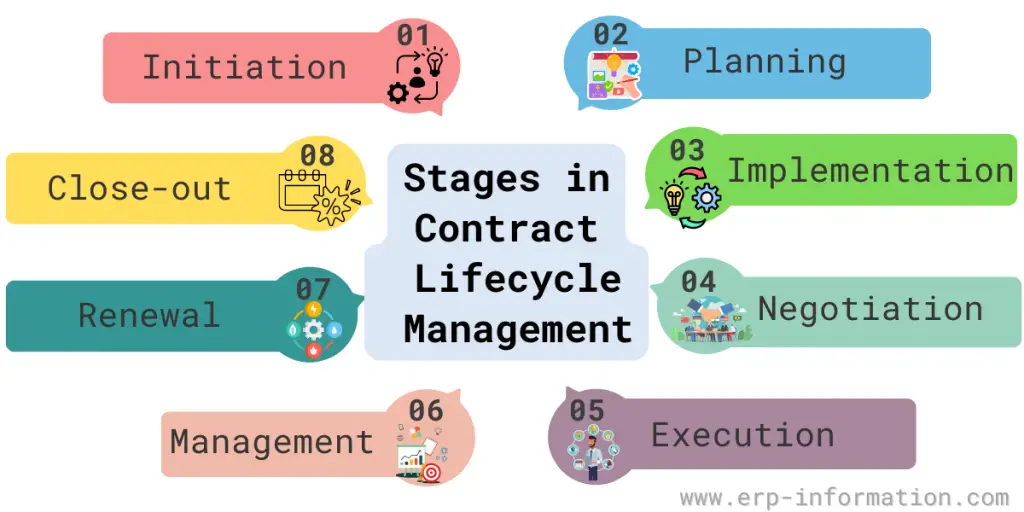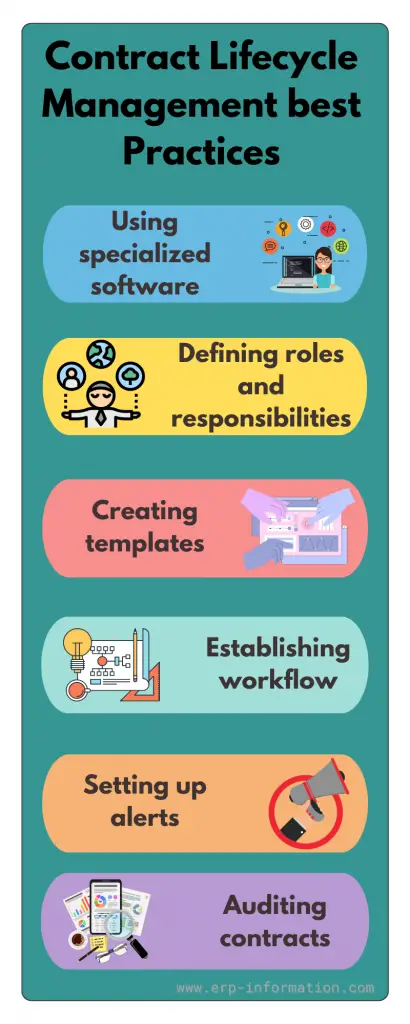Contracts are critical to any business, but managing them can be difficult and time-consuming.
Contract management can be a huge pain. You have to track when contracts are created, modified, and terminated. You need to keep track of who the contract is with, what the terms are, and when it expires.
The contract life cycle management system makes managing your contracts easy. It tracks all vital information about your contracts, so you don’t have to. It also helps you automate contract-related tasks like renewals and reminders, so you never forget an important deadline again.
This blog post will discuss the definition of contract life cycle management and its stages, benefits, challenges, and best practices. Additionally, we will also list the best CLM solutions.
What is a Contract Lifecycle?
The contract lifecycle is the process by which a contract is created, negotiated, executed, and managed. The entire contract lifecycle includes all the activities and milestones from the initial ideas or needs through post-delivery phases such as close-out or termination.
The key to effective contract lifecycle management is having visibility into every stage of the process so that you can identify risks, mitigate problems, and optimize performance.
That means clearly understanding who is responsible for what at each stage and standard operating procedures for completing work.
What is Contract Lifecycle Management?
It is the business process of managing contracts from inception to closure. CLM software applications help organizations automate the CLM process, including contract creation, approval routing, tracking, agreement management, contract renewal, and reporting.
CLM systems aim to ensure that all contracts are managed consistently and efficiently, with minimal risk to the organization. Contracts can be a significant source of trouble for an organization if not appropriately handled.
Therefore, contract processes must be tracked through their entire lifecycle to ensure that all terms and conditions are met and that no risks are taken concerning the organization’s legal obligations.
Stages
Initiation
Initiation is the first stage in the contract lifecycle when the organization recognizes the need for a contract. For example, when a company wants to buy supplies from another company, it will initiate the contract process.
Planning
Planning is the second stage, during which the organization develops a plan for the contract. It includes planning a strategy for a Contract lifecycle management solution depending on the enterprise’s requirements and resources.
Implementation
Implementation is the third stage, during which the organization carries out the plan. It includes developing contracts according to plan and communicating the objectives clearly to all employees.
Negotiation
In the negotiation stage, both parties agree on the terms of the contract. That is often done with the help of lawyers to ensure that all times are fair and legal.
Execution
The contract is executed or signed after negotiation. That is when both parties are legally bound to the terms of the contract.
Management
The management stage is when the contract is in effect, and both parties fulfill their obligations. Then, the organization monitors and manages the contract to meet its terms.
Contract Renewal
The contract may be renewed if both parties agree to extend it. Contract renewal includes renegotiating the contract terms and executing a new contract.
Close-out
The close-out stage is when the contract is completed and all obligations have been fulfilled. This stage includes terminating the contract and archiving it for future reference.
Implementation strategy
Central repository
Many businesses need a place to store their contracts. But, unfortunately, this means they can’t see all the contracts. Companies can quickly get visibility into their contracts by using a contract management system and adding old and new contracts.
This system will also add information like when the contract ends, so it can send alerts before the end date. The extra info makes searching for specific contracts in the repository easy.
The central contract repository helps ensure the right people can see contracts. For example, the contract owner can decide who should be able to view it and when they can see it.
Contract authoring
Companies use a contract management solution to write contracts in the system. Instead of just uploading contracts, companies create or upload clauses into a central repository and use those clauses to make templates.
Templates are used as the starting point for writing contract documents. Then, the contracts can be saved in the central repository, and people from within the company can help work on it with whoever wrote it.
Advanced integration
Advanced integration is a way to ensure that the legal contract we create with our supplier is transferred from the legal contract into our system, so it can be used to create an operational contract. This means that all the information about payment terms, suppliers, products, and prices will be handled.
Benefits of contract lifecycle management (CLM)
- Improved efficiency: CLM can help organizations to streamline their contract processes, making them more efficient and less time-consuming.
- Improved visibility: It provides organizations with visibility into all stages of the contract lifecycle to identify risks and potential problems early on. It provides more visibility to business contracts.
- Improved quality: It can help improve the quality of contracts by ensuring they are well-organized and adequately managed.
- Reduced risk: CLM can help to reduce the risk of contract-related problems, such as missed deadlines, by providing visibility into the contract lifecycle and offering tools for managing and tracking contracts.
- Improved compliance: It helps organizations ensure that their contracts comply with applicable laws and regulations.
Challenges
Despite the many benefits, there are also some challenges that organizations may face when implementing CLM. These challenges include:
- Complexity: The contract lifecycle can be complex, with many different stages and tasks involved. That can make it challenging to manage contracts effectively without the help of specialized software or services.
- Cost: Implementing a contract lifecycle management system can be expensive, particularly for large organizations with many contracts.
- Change management: Implementing Contract lifecycle management can require significant changes to an organization’s contract processes and procedures. That cannot be easy to manage and may require training for employees.
Best Practices
Using specialized software
Specialized contract lifecycle management software can help organizations to manage their contracts more effectively. Many CLM software is available in the market at a competitive price.
Defining roles and responsibilities
Organizations should define the roles and responsibilities of employees involved in the contract lifecycle. That will help to ensure that everyone knows their tasks and responsibilities.
Creating templates
Organizations should make templates for commonly used contract documents, such as NDAs (Non-Disclosure agreements) and purchase orders. That will help to ensure that all contracts are consistent and meet the organization’s requirements.
Establishing workflow
Organizations should establish a workflow for the contract lifecycle to ensure that all contracts are processed consistently and efficiently.
Setting up alerts
Organizations should set up alerts to notify them of important events in the contract lifecycle, such as approaching deadlines or expirations.
Auditing contracts
Organizations should periodically audit their contracts to ensure they are managed effectively.
Best Contract Life Cycle Management Software
The seven best contract lifecycle management software vendors based on user reviews are:
1. ContractWorks
ContractWorks helps businesses manage their contracts more effectively. It offers many features, including contract templates, workflow automation, and document management. ContractWorks also provides a mobile app for iOS and Android devices.
2. ContractLogix
It helps businesses automate their contract lifecycle, from creation to expiration. ContractLogix offers many features, including contract management, workflow automation, document management, and e-signatures.
3. Ironclad
Ironclad is a cloud-based contract management software that helps organizations manage their contracts more effectively. It offers contract creation, management, tracking, and reporting features.
4. SAP Ariba
SAP Ariba is a cloud-based procurement and contract management software that helps organizations manage their contracts more effectively.
5. Icertis Contract Management Software
Icertis is a contract management software that can automate and accelerate your entire contracting process. It gives users visibility into all aspects of their contract portfolio and helps them identify and mitigate risks associated with their contracts.
6. SirionOne Contract Management Software
SirionOne is a contract management software that helps organizations manage, track, and report their contracts. It offers a central repository for all contract-related documents and a robust set of tools for negotiating, drafting, and signing contracts.
7. Salesforce
Salesforce is a contract management software that offers a complete solution for managing contracts, from creation to expiration.
FAQs
What is Contract Management System?
A contract management system is a tool that enables organizations to manage their contracts. It offers a central repository for all contract-related documents and a robust set of tools for negotiating, drafting, and signing contracts.
What is Contract Lifecycle Management PDF?
It is a comprehensive guide that covers all aspects of the contract lifecycle management process. It includes detailed planning, executing, and optimizing the contract lifecycle management process.
Conclusion
Contract lifecycle management is a process that helps organizations manage their contracts more effectively. It includes creating templates, establishing workflows, setting up alerts, auditing contracts, and more.
It can automate and accelerate the contract lifecycle management process. As a result, a successful contract management process offers many benefits, including improved efficiency, greater visibility into the contract portfolio, and reduced risks.
It is essential to any organization’s contract management strategy.
Reference


